#friction reduction
Explore tagged Tumblr posts
Text
The Science Behind PTFE Seals: How They Reduce Friction by 90%
Introduction to PTFE’s Friction-Defying Properties Polytetrafluoroethylene (PTFE) has revolutionized sealing technology with its remarkable ability to reduce friction by up to 90% compared to traditional materials. This fluoropolymer, best known by the brand name Teflon®, possesses unique molecular characteristics that make it ideal for applications where low friction and high chemical…
0 notes
Text
How to Avoid Blisters While Hiking
Discover our top tips for blister prevention on your hiking adventures. Learn how to keep your feet comfortable and pain-free on the trail with our expert advice.
Blisters can be a real pain for hikers, literally and figuratively. These pesky skin irritations can turn a pleasant outdoor adventure into a downright miserable experience. But fear not – we’ve got your back (and your feet!) with our top tips for blister prevention. From choosing the right hiking footwear to advanced strategies for toughening up your soles, we’ll ensure you can tackle the trails…
#blister bandaging#blister pads#blister prevention#blister tapes#blister treatment#boot fit#break-in-period#callus formation#foot care#friction reduction#hiking footwear#hiking shoes#hiking socks#moisture wicking#shoe selection#wound care
0 notes
Text
Oil Change 101: Why, When, and How Often?

A fundamental component of a vehicle care routine is regular oil changes. It can help you take a proactive step in preserving your vehicle’s health and performance, ultimately saving you money and preventing avoidable mechanical issues in the long run.
Read More: https://www.thecarlofts.com/oil-change-101-why-when-and-how-often
0 notes
Link
45 notes
·
View notes
Text

The Colossal Importance of Washers in Constant Torque Clamps
Constant torque clamps are indispensable in applications requiring reliable and consistent clamping force. The inclusion of washers in these assemblies enhances their performance by ensuring even load distribution, preventing wear and corrosion, maintaining stability, and facilitating maintenance. By understanding the importance of each component in a clamping assembly, engineers and technicians can ensure the longevity and reliability of their systems.
Why Are Washers Imperative To Constant Torque Clamps?
Incorporating quality washers with constant torque clamps not only improves the efficiency of the assembly but also contributes to the overall safety and durability of the application. Whether in automotive, aerospace, or industrial settings, the right combination of clamps and washers is essential for optimal performance.

Washers act as a barrier between the clamp and the material, reducing direct contact and friction. This helps in preventing wear on both the clamp and the material. Additionally, washers can be made from materials that are resistant to corrosion, providing an added layer of protection in harsh environments, thereby extending the lifespan of the components involved.
Constant Torque clamps are crucial for applications needing consistent clamping force. Adding washers enhances performance by distributing load evenly, preventing wear and corrosion, maintaining stability, and facilitating maintenance. Quality washers with constant torque clamps improve efficiency, safety, and durability, making them essential for optimal performance in automotive, aerospace, and industrial settings.
#Importance of washers in clamping#Friction reduction in clamping mechanisms#constant torque clamps#reliable clamping solutions#Load distribution in clamps
0 notes
Text
Recommendations for societies with mixed halfling/human races follow. The average halfling is assumed, from demographic estimates, to weigh 30 pounds (14 kg) and stand approximately 3 feet (1 meter) tall.
All public places where people are expected to be seated need a mix of regular/small seating. Ideally, all chairs and tables will be adjustable, but this comes with cost considerations.
All doors must be accessible for people of all sizes. This presents a challenge for doorknobs and door handles, and the recommendation is a long vertical bar accessible for both, along with low "minimum force" levels for opening and closing. Problems with locking mechanisms remain, and while floor bolts are height-neutral, they're more suited to secondary locking mechanisms.
All restaurants, cafeterias, and vending machines should stock two differently sized portions. The average halfling consumes roughly a third the amount of food as a human. Because of various frictions (packaging, labor), prices are expected to be more than one third for a halfling portion. Because of this, it's best to have systems in place that allow splitting human-sized dishes, or bringing home leftovers, or making packages resealable.
Housing presents a serious problem. A single-family dwelling for a halfling family requires roughly one fifth the volume as for a single-family human dwelling, though costs do not scale down at the same rate. However, if built to halfling scale, the interior of the dwelling will only be accessible to halflings, which presents serious problems for e.g. police, firefighters, social workers, repairmen, or anyone else who might have cause to go into the interior of the home, to say nothing of friends and coworkers. Building for halfling scale is attractive for a variety of reasons, with cost being one of the biggest, but this might result in de facto segregation, and puts considerable strain on civic infrastructure and city markets due to duplication. Another social concern is that all interactions might, by default, take place inside human homes which have worse accommodations for halflings. Special note should also be made of mixed-species couples, who suffer extra burdens within the household. These problems are intractable, as some trade-off must always be made.
Tools, household goods, and clothing are naturally split into two markets. For clothing, near-complete segregation is expected. For everything else, partial segregation is expected: a halfling cannot effectively use many human tools due to differences in grip strength and grip circumference, to say nothing of brute strength. However, many consumables can suit both species, and it's expected that cost reduction efforts will inevitably result in a single offering for both in cases where that makes remotely makes sense. Purchases using refillable containers from bulk are encouraged, as each person can determine what's best to fulfill their own needs.
Due to lower costs (housing, food, clothing), halflings can in theory work for lower wages. For certain jobs, particularly those requiring physical strength, humans are more capable on average, and for others, particularly those requiring manual dexterity, halflings are more capable on average. For jobs which do not have significant differences, wage discrimination is recommended by contentious, and is an ongoing conversation.
There are a number of "segregationist forces" in society, driven by convenience, culture, and market forces. Once segregation has become, there is every expectation that it will snowball: a neighborhood which is inaccessible to humans will have businesses that cater only to halflings, and once halfling business is concentrated, any "mixed" business has less incentive to cater to halflings. Legislation can counterbalance these forces by requiring that all businesses be able to service both humans and halflings, and accommodate both human and halfling services, but this admittedly comes at enormous cost.
Overall, there are certain recommendations that are nearly costless and can be implemented as best practices immediately, and more complicated, costly reforms that will take significant political will and budgetary consideration. Beyond that, there are questions of social engineering and the level to which it is important or preferable that these things be done.
169 notes
·
View notes
Text
Hey folks let me anti-doomscroll you for a quick second:
Batteries and Solar have been getting cheap very quickly for a long time now and not only is it not stopping, but even at the rates it's at the economics of energy are shifting rapidly. The costs of decarbonizing all forms of electric power are now more down to infrastructure and planning than bulk cost. Compare and contrast to the turn of the century when Solar was so prohibitively expensive that saying we'd meet any meaningful fraction of our needs with photovoltaics would have gotten you laughed out of the room.
Meanwhile, although there are lots of complicated moving parts and a surprising amount of gross politics attached, gas cars are now less good in most ways than electric. Again, at the turn of the century this would have sounded laughable.
Many industries have specific needs that prevent direct conversion to electric, but hydrocarbon fuels are not intrinsically fossil fuels and can be made as a storage medium for solar. Hydrocarbon fuels made in this way are intrinsically carbon neutral. The technology is relatively young, but from a basic math perspective looks very doable.
Inflation actually has more to do with the above than it does with whatever it is the federal reserve does, and pulling down a supply of energy from the sky that requires less infrastructure to get (which is true because that's why it's cheaper now) directly helps.
The current "business as usual" scenarios with global warming are lower than they used to be, because the solar transition is just sort of happening because of economics without a lot of government help. All of the above lower the amount of friction and pushback we face when trying to get the government to do something.
By the way, the Inflation Reduction Act, passed by Joe Biden a couple years back, is explicitly designed to accelerate these trends.
As disastrous as the current projections for global warming are, it's important to keep two things in perspective: first, that they are exactly that, disasters, not the end-of-the-world kind but more sort of the hurricanes and floods kind, and second, while they certainly will get worse before they get better, they can and will get better. What we do now from a policy perspective has an outsize impact on how much flooding, droughts, and other weather-related costs we will face in the decades to come, but "human civilization ends" is not actually particularly likely. It is much more realistic to say "we could have a huge number of climate-related disasters or a moderately increased number, and every little bit of policy work helps move the needle".
We can and we will solve global warming, the question is not if but when, and how many lives can we save or improve by acting as soon as possible. Imagining this as an almost-certain death sentence for the future of humanity and nature is not merely unrealistic, but wildly counterproductive. It is paralyzing and enervating when what will do the most good is planning, policy, and communication.
Remember, despair is not a tool for positive change. Hope is the real language of revolution.
456 notes
·
View notes
Note
I think there's a Thing where any transphobia known to be against a transfem gets called "transmisogyny", which is fine I guess, but idk I feel like transmisogyny is supposed to be the word for the Specific Type of oppression that trans women face, not "transphobia that in this case is against a trans women". Does that make sense? Like if somebody misgenders a trans woman and that's it, that isn't anything more specific than "transphobia", right? Like if somebody were to call me a faggot, I wouldn't consider That transandrophobia simply because I Am a trans man, I would just think of it as generally anti-queer. Does that make sense, or am I misunderstanding the terms transmisogyny, transandrophobia, etc?
No I think you're right, and tbh I think it's a manifestation (and a really good example) of the "identity = oppression" framework a lot of folks are operating under in these conversations.
It's not something anyone really says out loud, but I've noticed it as a pattern in certain circles; mostly a lot of primarily young, online queer circles.
It's the same framework that, imo, spawned "Transmisogyny Exempt/Transmisogyny Affected" (or "TME/TMA") in which one's identity is directly equivalent to the oppression they experience.
The logic goes: If you identify as X, you experience anti-X oppression. If your identity is not X, you do not, and cannot, experience anti-X oppression.
This is also where we get, like, "misdirected misogyny" as a concept: the logic is that trans men* do not identify as women, therefore they cannot experience oppression meant for women.
Or "slur discourse": if you do not identify as X, you do not experience anti-X oppression, you have never been called this anti-X slur, and therefore you cannot reclaim this anti-X slur.
A lot of other gatekeeping arguments follow similar logic, as do a lot of arguments against acknowledging "transandrophobia" (or anti-transmasc bigotry as a specific concept). Personal identity is understood to be directly equivalent to experiences with oppression, and trans men's identities are thus broken down into their two parts, and assigned corresponding experiences:
Trans experiences
Man experiences
Even understanding "trans man" to be a third identity, with additional, unique "trans man experiences", creates a lot of friction within this framework: a lot of the unique "trans man experiences" we talk about arise from interactions between transphobia and misogyny. But misogyny must be woman-only; our experiences with misogyny are considered incidental, or "misdirected".
If we consider identity to be directly equivalent to oppression, then what, exactly, could these unique "trans man experiences" be?
In this framework, they can only ever be the combination of "trans experiences" and "man experiences"; and "man experiences" cannot contain any unique "man oppression" (unless all men are oppressed just for being men), so "trans man experiences" can only ever be "trans experiences".
When people say "transmisogyny" to refer to any and all oppression that impacts trans women, it's because they understand identity and oppression to be one and the same. Trans women's experiences with oppression cannot be understood as complex & nuanced interactions between different systems of oppression- they are always considered transmisogyny, because the person experiencing them is a trans women, and the oppression of trans women is called "transmisogyny".
It's a reductive and honestly immature understanding of how identity and oppression interact with and relate to one another, but I find it really helpful to understand it when breaking down the flaws in arguments like these ones.
*Some trans men (as well as other transmasculine people) can and do identify as women, and this logic is often applied to transmasculine people as a whole, which erases those folks as well. I'm just not sure what the most accurate term to use here is, honestly.
171 notes
·
View notes
Text
The Carter/Reese kiss came up on my dash again...
I've always thought John Reese can love and care about more than one person at a time for different reasons. This doesn't do a disservice to any character and I find it incredibly reductive to think so.
Behind the scenes, it was an emotional alternative take that the writers chose to include in the final cut of the episode, despite the showrunners' apparent disinterest in a Reese/Carter relationship. Both actors said the lines sort of called for it and I can see what they meant. I fail to see how the kiss ruined anything about Reese and Carter and Finch, unless one thinks character roles are radio buttons and you can't check [BADASS] without unchecking [LOVE INTEREST].
Reese's relationship with Finch is special; Finch gave him a purpose and the means to fulfill it but that doesn't cancel the fact that their story starts with Finch wanting something out of Reese and effectively getting it through manipulation. There is a lot of friction and distrust in the beginning and Reese is smart to be wary. It might be me, but I like the ups-and-downs of this relationship, the arguments. Nonetheless, Finch proves himself to be magnitudes better than his old bosses, a leader he can follow. Instead of leaving him to the wolves at the end of Number Crunch, the "middle-aged cripple" comes for him, and saves his life. Reese puts his life on the line for him when he's kidnapped, and so on, and so forth, they stumble along together, trying to right their wrongs.
Carter on the other hand doesn't have that kind of baggage. It's not the same dynamic. She takes one look at him at the station and understands what he's going through. She is a working woman, a single mom and she was in the same path as Reese to an extend but she made good decisions and ended up different. I think Reese recognized that when they first talked. She did what he strove to do and failed and he feels that with the power Finch and his machine granted him he can protect the ideals she upholds even if he can never live up to them. He does say the world can't afford to lose her and has always, from S1 tried his damnedest to protect her. Now this isn't very well communicated in the show because Reese's active suicidal tendencies were cut (they wanted to have Reese dangling from a bridge but the city prohibited filming there) but this is what I think the "You changed my mind" line means. Carter, being the person that she was, gave him a nudge in the police station. When he was on his feet, she became his anchor, through her good work and character.
In the end, Finch gave him the purpose, the means. Carter was the ideal that he was fighting for.
#i saw the careese kiss again in hd and slowmo and got a little emotional here is an incoherent essay#i just feel that reese is a complex character with complex emotions and complex relationships with other complex characters#but it all gets reduced down to trope labels#same with carter#now a truly reductive canon relationship is reese/iris but that's a whole barrel of worms and im not opening it#person of interest#john reese#joss carter#harold finch
49 notes
·
View notes
Text
It has occurred to me that Chocolate Guy/Amaury Guichon could probably make a fully edible clock.
So old timey grandfather clocks work by swinging a pendulum from side to side. The definition of a second (until we standardised it to the speed of light) was created just after the 1789 French Revolution as the amount of time it takes for a 1-metre long pendulum to swing from side to side. Yes, any weight on a string that is exactly one metre will stabilise into a 1-second swinging motion (at least until friction slows it down too far).
So this swinging motion engages a ratchet gear that is under constant torque. This is done with either a spring, or a heavy weight on one side of the ratchet gear. The ratchet is such that it will turn only when the pendulum is at the bottom of its' swing. And voilà, you have a wheel that spins a certain amount every second, without fail, using only gravity.
Which could theoretically be made out of chocolate.
The problem is actually the bearings. Chocolate on chocolate has a lot of friction. What sweet thing/edible thing can be used instead?
Hard waxy sugar, like the shells of Mentos or Skittles or M&Ms is a possibility.
Potentially, gummy bears shaped into troughs with olive oil would have very low friction indeed.
The reduction gears needed to turn seconds into minutes and hours also need to be low enough friction to not gum up.
The cables to hold the weights could be made from gelatin, if the weights are small enough.
We could, if we tried hard enough, make a fully functional chocolate clock.
Oh, and the Ferris wheel he made that one time? That can also be powered to turn using gravity too.
20 notes
·
View notes
Text
i just find it really interesting how i’ve been seeing a handful of people deciding that of all the hex, quincy is The Biggest Hater and that he’s markedly more mean/rude than anyone else when in actuality, ARTHUR is usually the one reacting harshly towards HIM in a lot of their back-and-forth during the gameplay demo. he’s dismissive of arthur when he asks about his keys, yeah, but not really moreso than anyone else was — amir ALSO tells arthur not to bug him cuz he’s busy and is pretty short with him too, at least relative to the rest of his dialogue, but we don’t hear too much about that in comparison for whatever reason… and then during the actual gameplay, when he’s shooting down targets before arthur can get to them, arthur gets pissy with him about it when quincy is Literally just watching his back and helping him. he signs his note to arthur about parking his bike wrong ‘with love’ and is equally on board as everyone else with them all working as a group when arthur gears up to head out rather than letting him rush out there on his own, something that arthur seems a bit bothered by.
i think the conflict between them is much less ‘quincy is a hater and doesn’t like arthur’ and much MORE ‘quincy is clearly skilled and confident in his skills, arthur is more of a loner and seems to have mantled the leadership role in this situation, so he feels almost ‘threatened’ when quincy’s competence approaches or even surpasses his own and suddenly he isn’t The Only Man For The Job anymore” type thing. quincy isn’t immediately deferring to him as The Guy In Charge and that seems to intimidate him, most likely because he thinks that quincy is trying to undermine him rather than considering that quincy might just want to approach this situation all on equal footing like allies rather than having ANYONE default to being The Leader. like honestly regardless of if quincy is genuinely just being friendly and trying to help sincerely or if he’s fully aware that it pisses arthur off when he snipes enemies right in front of him and is doing so anyway — either to be passive aggressive about arthur’s attitude OR because he just doesn’t care that arthur’s ego gets bruised so much as he cares about keeping everyone alive as his top priority, not tallying who gets the most kills — there’s really not a lot of outward antagonizing one another AT ALL between the hex that we’ve seen so far. they each comment on finding someone annoying or resenting them or not trusting them to themselves, yeah, they butt heads over things here and there, and there’s obviously a lot of friction caused by each of them having their own baggage and being in a high stress situation. but i think characterizing ANY of them as being Mean On Purpose is kinda reductive and honestly ignores the potential for much more interesting interpersonal dynamics that could be going on here that i’m personally hoping to see more of
40 notes
·
View notes
Text
Thinking today about my favorite ever work nemesis.
I couldn't fucking stand this woman. She had a habit of making everything going on in the office about her, would regularly get riled up because she had decided, with crystal clarity, that someone had said the exact polar opposite of what they had said and demand an apology from them, and would actually yell and storm out of staff meetings.
She, similarly, couldn't stand me. Probably because I would actually roll my eyes when she got dramatic, I wouldn't apologize to her for complimenting her on an area of expertise when she had decided I had somehow said the opposite of what I had said, and because she decided I was invalidating her, specifically, for accurately noting that I have a grandfather who grew up on a reservation.
So. Animosity.
But here's the thing- we knew we needed to work together anyways. And through it all, she did actually care about the clients, and so did I.
So whenever we'd have friction, she'd find an excuse to wander over to me sometime later that day, or even within the conversation we were having, and ask to see pictures of my then-infant daughter.
She genuinely liked babies and pictures of babies. I was always down to show off my extraordinarily cute child. We could have a nice, de-escalated moment. Was she handling me? Absolutely. I knew it. But I appreciated the effort. It did lower the tension level. It gave us a common ground.
I don't have any real point here except that sometimes it's good to have a de-escalated moment with someone with whom you share mutual antipathy. It was honestly mature of her to mitigate like that. It improved the work environment.
In some relationships you just don't have standing to ask someone to change in any deeply ingrained way. And that's what it would have taken for us to actually like each other or even feel truly neutral about each other. But yay for harm reduction.
The other lesson here is that my child is so adorable that she inspires peace and harmony by merely existing and being seen.
24 notes
·
View notes
Photo
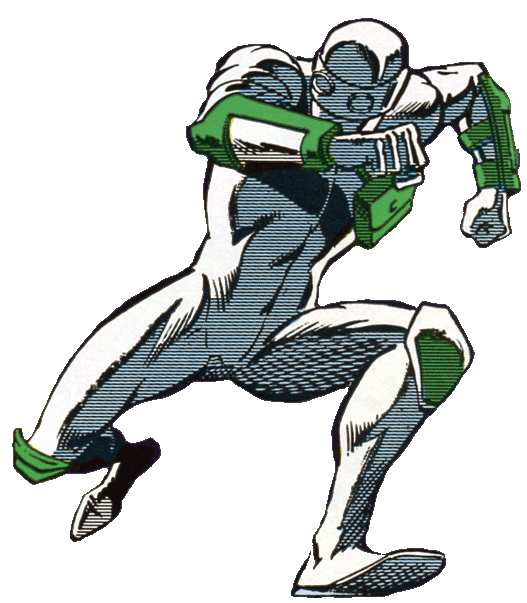

During the Initiative, when Hammerhead wanted to furtively undermine Kingpin’s territory, he tried to hire an intuitive pair of potential Science champs: the sticky guy Trapster and the slippery guy Slyde. Slyde is far too obscure to be a priority for the Wishlist, but he’d be a good obscure Champ, given his potential for interesting kit dynamics and the fact that he’s appeared more than a couple dozen times, including in an animated television show.
#obscure pairing#Slyde#Jalome Beacher#Matthew Beacher#NYPD#friction reduction#slippery#burglar#Spider-Man rogue#mcoc class science#villain#Black#Wishlist Cleanup
1 note
·
View note
Text
Found an Self-Insert Cyberpunk fanfic.
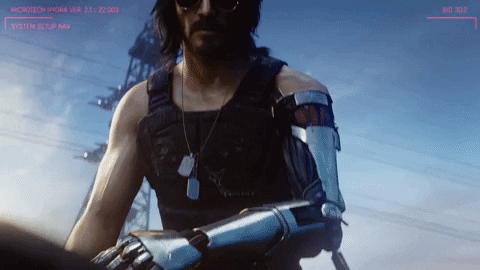
Except it's not the usual type. It's the type where it's told entirely from the perspective of people other than the SI, which makes it more interesting.
Problem 1: Current events.
Almost all the references people make are ones you'd expect from someone today, like Batman or other pieces of pop culture.

Cyberpunk 2077 often references fictional in-universe media. Like the dead rock star stuck in V's head. In a world where everything and everyone is disposable and temporary, why would people usually reference 80 year old media?
At one point, a character explicitly compares another character's clothing to Danny DeVito in Matilda.
Okay, the CP timeline divergences mainly started in the 90s. So it's possible that the movie was still made, but it's still odd. Especially when the same characters don't recognize that the story's lead is heavily based on Walter White. Shaved head and everything.
Except he's using his chemistry potential for good, not evil.
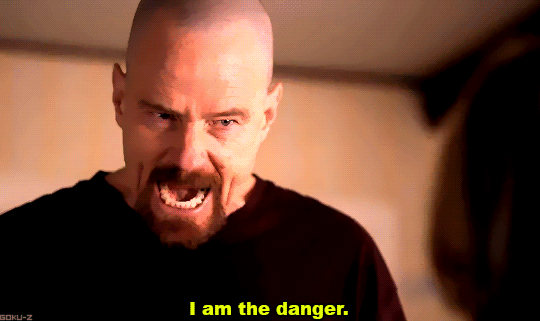
And it's not just media. It's also Current Year memes, like V describing certain people as a "corpo bros who watched too much American Psycho", or himself as a "disaster bisexual".
Oh look, a segue.
Problem 2: Rainbow connection.
The story puts a lot of emphasis on LGBT characters.
There's Judy Alvarez, obviously. But also, V's in with Meredith Stout is Stout's explicitly non-binary ex who, you guessed it, is they/them.
Adds nothing to the story. The SI provides that info, and Meredith tries to trip V up, but he sees through it.
Since Meredith is a Militech Corpo, and V is an Arasaka ex-Corpo (who still isn't over it), why doesn't V…just use that connection, somehow? Militech and Arasaka are rivals. There could be some friction there. Or V could sympathize with how Stout would do anything to keep her job.
Why are non-binary characters always just they/them? Why not he/she/they? He/She? Xi/xir? or Lunagender? Or using regular He or She interchangably while IDing as enby? Why is it always the basic, simple, "normal" version? Got a Rochester's Wife situation going on?*
Also, in fanfics, things like this often suggest even more awkward left-wing political insertions, down the line.
Problem 3: even more awkward left-wing political insertions.
Well, just one.

Panam Palmer just didn't fit. This wasn't rare in Night City. Lots of people who didn't fit in, were awkward, had no social groups, didn't choose to be loners. She expected to be alone in the city and no one cared. But it was personal hate. Her skin color, nomad markings, speech, just being a woman. The list went on and every day there was some new jerk who needed to find out, because they messed around.

Panam is canonically native American, according to the devs, but she looks like a random white biker lady wth a tan. Wouldn't be the first white-passing Native woman I've seen.

Also, she lives and works around Night City. Which is extremely diverse.
Judy Alvarez and Jackie (both Hispanic) were both POV characters, and race wasn't really mentioned. You'd think ex-Arasaka V or someone would mention Arasaka's racism, but nope. River Ward was a viewpoint character, and he's much more visibly non-white, down to his necklace and dreamcatcher (if romanced).
He only brings it up in the fic when Misty asks him if he ever had his fortune told. Apparently his granny did a "spirit walk" when him and his sister were born.**
I've seen playthroughs of the game, and I don't remember sexism really being a thing. Why would skin color matter much when anyone can change that and other ethnic features at will?
Why did race only come up as a significant thing now?
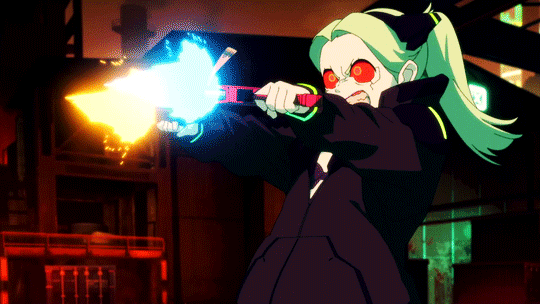
I'd expect Panam to get the most stick for being a Nomad, not brown, or a woman. Especially in a city where any woman could sprout mantis blades and go Cyberpsycho at the drop of a hat.

This feels…reductive. Like the writer wanted to give Panam challeges to overcome so she could be a Tough Woman™, and just…piled too much on, like a Chicago hot dog.

I would've gone with something more subtle. "Her back itches without her Nomad tribe behind her, and she's uncomfortable in a city instead of a desert, or a road. Even the echoes sound wrong."
So, yeah, this was the last straw.
Also, I checked the writer's profile, and, very stereotypically, she's from Portland.
*Also, you might recall that there was a nontroversy over an soda ad in the game featuring a lady with, ahem, a rather substantial bulge. Based on an actual trans woman. Somehow, portraying a (possible) trans woman in the same sexually objectified way as ads featuring non-trans people is transphobic.
I never worked out that logic.
My best guess is that some people were uncomfy with it, and it's about a trans person, so it's must be *phobic somehow.
Wouldn't it be ironic if the ad was just Photoshop in universe? Or the in-universe model was a non-trans woman who strapped on the junk just for the ad?
(Though depending on who you ask, that still counts as being a trans woman, somehow.)
**Come to think, that kind of feels like it's stereotyping. I can't find evidence Pomo Native Americans do spirit walks, but maybe my Google-fu is just weak.
21 notes
·
View notes
Text
In her 2012 book, Addiction by Design, anthropologist Natasha Dow Schüll lays out the different technological mechanisms casinos employ to keep people gambling. From the architecture of buildings and placement of ATMs to the design of casino carpets—all of it exemplifies strategic calculation. As a blurb for a gambling trade show once put it, the various elements making up the modern gambling experience are “symphonies of individual technologies” that come together to “create a single experience,” calibrated in a way to keep people playing, to maximize “time on device.”
Sound familiar? Schüll thinks so. “There’s something very similar about the mechanisms that are built into dating apps, especially with swiping,” she says. “Swiping left and right—it’s almost like a horizontal slot machine. You really don't know what you're going to get.”
Although Schüll doesn’t think these similarities are limited to just dating apps (she mentions the stock-trading app Robinhood), she does believe they all share one thing in common: strategies to hold users in place and reduce friction. So what does it mean then when friction enters the picture? When users spend less time in the “hold” and less energy on the machine?
It’s true that the amount of time spent on dating apps has declined over the years. A recent Forbes poll of dating app users showed that, on average, they spend about 51 minutes per day on them. Ten years ago they were devoting 100 minutes daily to platforms like Bumble.
It’s also true that the growth of paying users has slowed down of late, accompanied by a slight dip in the number of Americans who say they use dating apps. However, one app in particular is down much more than any other—Tinder, creator of the swipe. Though Tinder still holds the title for most commonly used dating app, its overall downloads have been dropping since 2020, while downloads of apps like Bumble and Hinge have continuously increased since 2021. Tinder has also seen a reduction in its paying users over the past two years, while its monthly active user numbers have dipped in the past three quarters.
Explanations for this decline are as numerous as the number of dating apps on the market. “It could be some wearing off of the novelty effect, it could be disappointment, it could be that there’s other activities that are taking their time, like sports gambling, it could be exhaustion,” says Schüll.
To her last point, dating app fatigue is a real thing. That same Forbes poll showed that 80 percent of millennial users—the group that utilizes these apps the most—reported feeling worn out.
Another cause attributed to this decline is the dating app exodus, which occurred after a spike in usage during the pandemic, as many young users are now seeking more “real-world” connections. And of course there’s that age-old tedium: boredom.
“In design, they're constantly upping the ante—if there’s a video poker machine, then there’ll be triple video poker, and then it's 10-play video poker, 100-play video poker,” Schüll says. “When you move to the next one, you sort of can’t go back. So it's a tolerance effect. Maybe these apps exhausted the potential to hold people to a certain point and didn't do that work of taking it to the next, higher, more intense level.”
Regardless of the reason for the decline, one thing is for sure—dating apps are still alive and will not go away anytime soon. And if there’s anything to take away from the fact that people are jumping the Tinder ship for other dating apps, let it be that the real contenders for our love and attention are the ones that aim to hold us in place the longest. The ones that want us to keep playing the game forever.
Yes, Dating App Usage Has Somewhat Peaked
Generally speaking, dating app usage plateaued during the time of the Covid-19 lockdowns in 2020. Between 2019 and 2022, the percentage of US adults using online dating sites dropped from 18 percent to 15 percent.

Generational Shifts in App Usage
Looking at the number of adults engaged in online dating doesn’t tell the whole story. In some cases, it’s a matter of some age groups falling off while others pick up the slack. In that same four-year span from 2019 to 2022, the number of US adults ages 30 to 49 who said they had ever used a dating app or site dropped by a percentage point, while more people ages 18 to 29 and 50 to 64 got into the game.
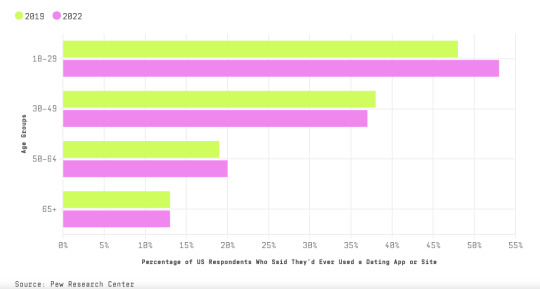
No More Pay to Play
One thing about dating apps that people are tired of? Paying for them. Growth in the number of users opting to pay for premium dating app services is petering out.
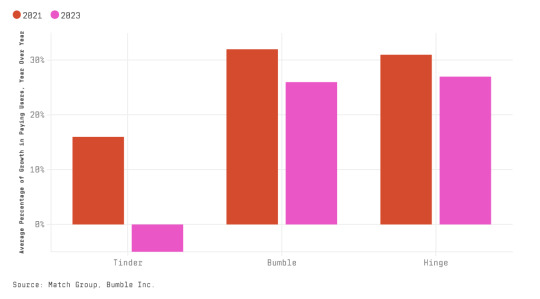
Millennials Spend Less Time Swiping
In 2018, millennials spent 90 minutes a day on dating apps. By last year, that number was down to nearly 56 minutes per day.

The Big Shift in Dating Apps? Which Ones People Use
Despite all the changes in online dating habits, the biggest shift isn’t that people are leaving apps, it’s that there are shifts in which ones are popular. The app that’s taken the biggest hit? Tinder. While total dating app downloads worldwide have remained above 120 million annually since 2020, the Tinder slice of that download pie has gotten smaller, while apps like Hinge and Bumble have seen an increase in downloads—a bit of a sick burn for the app that started it all.
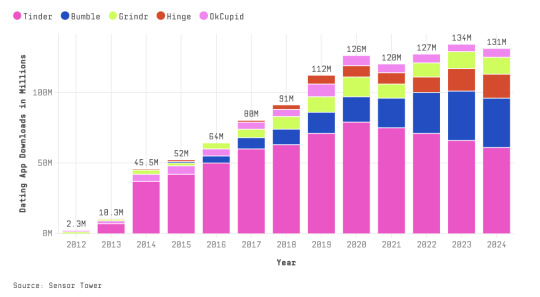
10 notes
·
View notes
Text
Petrified like Medusa: A Post about Catatonic Dissociation. (more like how catatonia and dissociation work, creating a devastating combo. oof!)
Have you ever got that feeling where you cannot move your limbs, say a word, or even breathe? Do you feel like all your functions had stopped as if it's a statue? Where everything ceases to a halt as your body betrays whilst doing your daily activities? Something else might felt wrong and odd too;
It's not just your imaginary,, it is something real that us, systems sometimes experience. May this post bring you understanding of today's topic!
The difference between catatonia and dissociation
Catatonia is similar to freeze response, the only difference lies on the reason, which is: it is usually a byproduct of something (usually by overwhelm), while freeze activates from stressful situations. Being catatonic means:
Stuck in a position, no matter how uncomfortable or what pose you're at.
Find it hard to execute/keep up with basic actions such as eating, drinking, breathing, or even blinking!
You find yourself actively struggling/fighting against the heavy friction of the unmoving body. Or is absent from any forms of thoughts, seemingly empty inside out.
Stiff, rigid movements, making soft skills harder to perform.
--
Dissociation on the other hand, is an active defense that works by flinging you out from there by any means. Making you feel physically + emotionally detached, and mentally not engaging the situation. It is a veil that blurs the details and such, minimizing as much damage as possible.. it can look like:
The world looking a bit slow, distorted, or unclear.
Tactile sensations and sounds feel toned down and damped.
Your thoughts and movement may or may not get sluggish/lagged.
Memories feels fuzzy, preventing clarity of the situation.
How it affects us, systems..
Catatonic dissociation can happen when we are faced with inevitable, stressful moments. Depending on how bad the situation is,, when you're dissociating, catatonia can slowly creep up on you and petrify everything from top to bottom.. like medusa; This alone can hinder the communication and body coordination in systems.
Luckily, you can be aware of the warning signs soon before it sets in, pay attention to:
Feeling a huge reduction in movement, or have confusion of it.
It's harder to speak clearly, possibly restricting volume or vocals.
You are unbothered when someone is pushing you, for example. And stayed passive/still trying to process what happened.
Finding yourself standing/sitting/etc longer than you'd expect to.
A change in switching patterns, or show clear struggle in attempt.
Things feels like it skipped a beat, and you 'snapped out' every few moments. As if you were put into a trance.
--
Additionally, catatonia-like dissociation can also happen when you are in the middle of the process of a switch, feeling extra blank and unmoving until a new fronter completely took over, too! To minimize discomfort and possible injuries, practice caution by choosing a safe, comfortable spot beforehand.
The takeaway and tips to overcome this:
This episode is temporary, lasting from a few minutes to an hour or two (there might be instances that it will be longer). Frequency is subjective,
There are things that can be done to ease and lesson such discomfort or struggles; starting from planning a tactic for this situation, minimizing current triggers/stressors, finding a spot to lay down/sit although it'll be hard.. so take this step steady, and stay comfortable until it disappears by itself. Grounding techniques could help, though i have not tried them myself, feel free to test the theory.
Lastly, this concludes the end of the post! Thankyou for helping me decide which to do first, so please expect the other one to be out in a few weeks as i go down the rabbit hole, yet again. If you find this interesting, or helpful, or worthy of being shared to other people, i will appreciate every one of you who had read 'til the bottom of the post <3

- j, a very happy one
#did#actually did#did community#did osdd#did system#dissociative identity disorder#sysblr#plural#system stuff#jeducates
58 notes
·
View notes